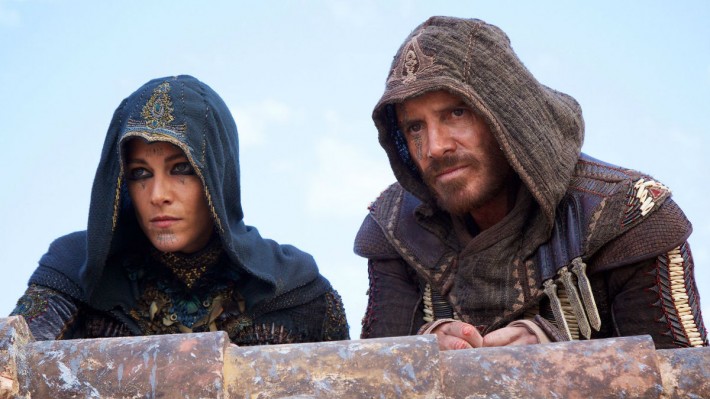Knights Templar: The history behind Assassin's Creed
Videogame franchise and film draw on true stories of a Crusader charity-turned-army and group of Muslim assassins

The featurette for the upcoming Assassin's Creed, a film adaptation of the popular videogames, delves into the mythology of Assassins and the Knights Templar, but does it have any basis in historical fact?
Due for release in December, Assassin's Creed stars Michael Fassbender as Callum Lynch, a prisoner forced by scientist Sophia Rikkin (Marion Cotillard) to go back in time and relive the life of his ancestor, Aguilar de Nerha, an Assassin operating in 15th-century Spain.
The new clip delves deeper into the mythology behind the Assassin's Creed franchise to discuss why the two are fighting.
The Week
Escape your echo chamber. Get the facts behind the news, plus analysis from multiple perspectives.

Sign up for The Week's Free Newsletters
From our morning news briefing to a weekly Good News Newsletter, get the best of The Week delivered directly to your inbox.
From our morning news briefing to a weekly Good News Newsletter, get the best of The Week delivered directly to your inbox.
[[{"type":"media","view_mode":"content_full_width","fid":"103221","attributes":{"class":"media-image"}}]]
In the video, Fassbender and Cotillard attempt to explain the centuries-old battle between the Assassins and Templars, drawing on the mythology of Ubisoft's original Assassin's Creed videogames.
The games, which have been praised for their attention to historical detail, are set in a fictional version of real-world events. They follow the struggle between the Assassins, who fight for peace with free will, and the Templars, who desire peace through control.
Was there a real guild of Assassins?
A free daily email with the biggest news stories of the day – and the best features from TheWeek.com
The first game of the Assassin's Creed series allows players to take on the role of Altair, a 12th-century Assassin living in the city of Masyaf in the Holy Land during the time of the Third Crusade (1189-1192).
Historical records indicate there was a guild in Masyaf, which served as the headquarters of the Ismaili da'i Rashid ad-Din Sinan, the leader of the Nizari sect of Muslims, who are linked to Shia Islam, and this elite unit of fighters became known as the Hashashin ("Assassins").
The secret order often used espionage, guerrilla tactics and targeted assassinations to further their political and religious goals and keep their mostly Sunni and Christian opponents in check rather than engaging in risky open battles. Over the course of 300 years, they successfully killed two caliphs and many viziers and sultans, as well as Christian Crusader leaders.
Do the Assassins exist today?
While there is no evidence to suggest the Assassins continued their operations, the legend is said to be a continued motivation for insurgents seeing to replicate their methods and tactics.
Who were the real Templars?
The historical Knights Templar, like the Assassins, came to prominence during the Crusades, but their origin starts before that. They started as a charity set up to escort pilgrims to the Holy Land. When word spread of their good deeds, the order was officially endorsed by the Roman Catholic Church and gained special tax concessions from the pope.
These privileges gradually allowed the simple charity to transform itself into an elite military order and by the time of the Third Crusade, the order joined the fight for the Holy Land.
Known for their distinctive white cloaks decorated with a red cross, the Templar Knights were recognised as some of the most skilled fighting units of the Crusades. Non-combatant members managed a significant financial infrastructure throughout Christendom, building fortifications across Europe and the Holy Land and developing new financial techniques including an early form of banking.
The Templars were closely associated with the Crusades and when the Holy Land was lost, support dwindled. Their secretive practices became a source of suspicion and in 1307, Philip IV of France, who was heavily in their debt, took advantage of the public mistrust to have their leaders in France arrested, tortured into giving false confessions of sedition and burnt at the stake.
Pope Clement V disbanded the order in 1312 under pressure from Philip, but rumours of their continued underground existence persist to the current day.
Do the Templars exist today?
While certain conspiracy theories suggest the Templars carried on as a secretive order linked to other groups such as the Illuminati, which allegedly control world events, no historical records show any direct link.
The powerful reputation of the Templars, however, has led several societies, including the Freemasons, to incorporate symbols and rituals of the knights. Some even claim the Freemasons are directly descended from members of the order who took refuge in Scotland, aided by Robert the Bruce. But no historical evidence has been found to support this theory.
The Spanish Inquisition
Assassin's Creed the film creates the new character of Callum Lynch and follows a storyline set during the Spanish Inquisition – neither of which exist in the videogames. Lynch is forced to recall and relive the life of his ancestor, Aguilar de Nerha, an Assassin operating in 15th-century Spain during the time of the religious trials.
There is no historical evidence of any of the Order of Assassins being present in the country during this time – but the Templars are another matter. History shows that most countries complied with Pope Clement V's orders to dissolve the organisation, seizing the group's land. But in Spain, the Knights were still powerful, having been key to the success of the regime. The problem of their dissolution was solved by the creation of two new orders, the Order of Montesa and the Order of Christ, which many Templars joined as a way of retaining their lands and wealth.
Assassin Creed's mythology
The video game portrays heavily fictionalised versions of both orders. In the games, the Assassins are portrayed as having expanded beyond their Levantine borders and existing throughout recorded history, along with their nemeses, the Knights Templars.
Creed also represents the orders as basically philosophical, rather than as religious in nature, stating that they predate the Muslim and Christian faiths. This has allowed the game world to expand their respective "histories" across time, both before and after their actual historical time-frames.
-
 What is Roomba’s legacy after bankruptcy?
What is Roomba’s legacy after bankruptcy?In the Spotlight Tariffs and cheaper rivals have displaced the innovative robot company
-
 SiriusXM hopes a new Howard Stern deal can turn its fortunes around
SiriusXM hopes a new Howard Stern deal can turn its fortunes aroundThe Explainer The company has been steadily losing subscribers
-
 Unemployment rate ticks up amid fall job losses
Unemployment rate ticks up amid fall job lossesSpeed Read Data released by the Commerce Department indicates ‘one of the weakest American labor markets in years’
-
 How Bulgaria’s government fell amid mass protests
How Bulgaria’s government fell amid mass protestsThe Explainer The country’s prime minister resigned as part of the fallout
-
 Femicide: Italy’s newest crime
Femicide: Italy’s newest crimeThe Explainer Landmark law to criminalise murder of a woman as an ‘act of hatred’ or ‘subjugation’ but critics say Italy is still deeply patriarchal
-
 Brazil’s Bolsonaro behind bars after appeals run out
Brazil’s Bolsonaro behind bars after appeals run outSpeed Read He will serve 27 years in prison
-
 Americans traveling abroad face renewed criticism in the Trump era
Americans traveling abroad face renewed criticism in the Trump eraThe Explainer Some of Trump’s behavior has Americans being questioned
-
 Nigeria confused by Trump invasion threat
Nigeria confused by Trump invasion threatSpeed Read Trump has claimed the country is persecuting Christians
-
 Sanae Takaichi: Japan’s Iron Lady set to be the country’s first woman prime minister
Sanae Takaichi: Japan’s Iron Lady set to be the country’s first woman prime ministerIn the Spotlight Takaichi is a member of Japan’s conservative, nationalist Liberal Democratic Party
-
 Russia is ‘helping China’ prepare for an invasion of Taiwan
Russia is ‘helping China’ prepare for an invasion of TaiwanIn the Spotlight Russia is reportedly allowing China access to military training
-
 Interpol arrests hundreds in Africa-wide sextortion crackdown
Interpol arrests hundreds in Africa-wide sextortion crackdownIN THE SPOTLIGHT A series of stings disrupts major cybercrime operations as law enforcement estimates millions in losses from schemes designed to prey on lonely users